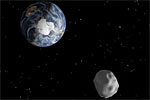


Tonight (Friday) the asteroid 2012 DA14 will whizz by our planet, closer than any other known asteroid in historical time. It will be invisible to the naked eye, but the object can theoretically be seen with binoculars (or watched on a NASA webcast). We have asked our chess astronomers (Dr John Nunn, Dr Christian Sasse) to try and capture the fly-by with their remote telescopes. We would also ask Vishy Anand, but he is unfortunately otherwise engaged – playing Georg Meier in round eight of the GRENKE Chess Classic in Baden Baden.
In case you have good binoculars or a small mobile telescope – one you can move across the sky at good speed, since the asteroid will cross an area of the sky as wide as the full moon roughly every 30 seconds – then here's the path that 2012 DA14 will take:

This finder chart shows the position of the asteroid during its period of
visibility. Times
given are GMT/UT. Click here
for a larger version. Photograph: University
of Hertfordshire
At its closest approach the 45 meter (150 feet) wide asteroid will zoom by earth at an altitude of 27,700 kilometres (17,200 miles). That is some 8,000 km (5,000 miles) closer than the geosynchronous satellites that supply your TV programs, but far above most Earth orbiting satellites, including the International Space Station, on which there are currently six astronauts working.

To celebrate the fly-by Google has used a doodle that shows the
small 'g' of the logo getting out of the way to avoid the asteroid.
Now comes the extraordinary new information – and the tenuous chess connection: early on the morning of the asteroid fly-by a huge meteor crossed the sky in Russia, exploding in a fireball over the city of Chelyabinsk, causing a substantial sonic boom that shattered windows and set off car alarms. Apparently a number of people were injured, but news with details on this is not yet in. Nor can the rumour be confirmed that pieces of the meteor reached the ground. Be weary of "impact pictures" of the meteor that are appearing in the news – we have spotted a number that are in reality shots of the Darwaza gas crater in Turkmenistan.
Of course scientists will be investigating the possibility that there is a connection between the meteor and asteroid – the coincidence of the exact same day is too incredible to ignore. John Nunn:
It’s not unreasonable to postulate a connection between the Chelyabinsk meteor event and this evening’s asteroid. The asteroid might once have been part of a larger object which broke up; the fragments would gradually become strung out along the orbit like beads on a wire, with a small divergence of orbits. Some would arrive sooner, some later. Given the excellent video footage it should be easy enough for scientists to determine the orbit of the meteor and see if there is a connection to the asteroid.
Addendum: NASA is now reporting that the meteor and asteroid appear unrelated – totally different orbits. So it was purely coincidental that the two objects appeared on the same day. Meg Urry, professor of physics and astronomy at Yale University, calculated the odds of this happening at 1 in 100 million. "But think again," she writes, "the Earth has been around for 4.5 billion years -- which is 1.6 trillion days. So the chance that these two events would happen on a day sometime in the earth's history is actually larger than we first thought -- it ought to have happened about 12,000 times already." Of course, during most of that 4.5 billion year history, the earth was not populated by intelligent life -- human beings who might have noticed the two events happening on the same day.
Cautious (and curious) souls will therefore be keeping their eyes open for additional meteor events. Remember: 2012 DA14, which is missing Earth by fifteen minutes, is a Tunguska-sized body that could completely flatten a major city. There are probably 100,000 such objects with earth-crossing orbits, and it is our feeling that we should be budgeting the same amount we spend on nail care or six hours of military spending on finding and tracking these potentially mega-catastrophic bodies.
Chelyabinsk has been the site of many big chess events since the 1950s (and earlier), and was in fact scheduled host of the October 2012 FIDE Grand Prix. Unfortunately a conflict between the Russian Chess Federation and FIDE, described by organiser Andrew Paulson in this CHESS interview, made it necessary to relocate the event to London. Another chess connection: the famous openings theoretician Evgeny Sveshnikov was born in Chelyabinsk, Russia, on February 11, 1950. And, as Christian Sánchez of Rosario, Argentina, reminds us, Zlatoust, one of the impact sites, is Anatoly Karpov's place of birth.
In Russia today dashboard video cameras ("dashcams") are fairly ubiquitous, and so the meteor explosion over Chelyabinsk was captured many times, and Youtube videos are going up faster than we can follow. Here's a small sample:
In this one you hear the sonic boom which comes some time after the meteor
has passed...
... and see the reaction of the camera people and the damage to windows
Here are employees in an office reacting to the blast
Many more videos have been posted on Ilya Varlamov's Live Journal, which is being constantly updated.

Ilya has also included a fair number of wonderful still images of the meteor,
and the
damage caused by the sonic boom in the city of Chelyabinsk.
Space rocks explained: Telegraph report on the meteor fall in Chelyabinsk